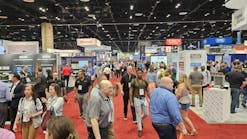PRESS RELEASE
MT. LAUREL, NJ - April 13, 2022 — NADCA, the HVAC Inspection, Cleaning, and Restoration Association, announced the publication of “Biological Air Quality Considerations for Non-Healthcare, as Built Environments,” a scientific paper developed in partnership with the Global Biorisk Advisory Council (GBAC).
The paper, funded by the GBAC, addresses several strategies for improving indoor air quality in facilities and built environments such as schools, restaurants, convention centers, and gyms.
Air quality has become a major focus of cleaning considerations since the introduction of the SARS-CoV-2 virus pandemic. This paper is designed to provide the measures a facility should take into consideration to control the spread of infectious agents within their facilities, with a particular concern for those spread through airborne routes. Viruses or other infectious agents that are transmitted through tiny droplets and aerosols are considered to be airborne diseases. SARS-CoV-2, influenza, chicken pox, and measles are all examples of airborne diseases.
- To download the new research, click here.
NADCA President and Chairman of the Board Mark Zarzeczny, ASCS, CVI, and NADCA’s scientific advisory board chair; Dr. Mark Hernandez, PhD, P.E., along with a team of scientific and industry peers; contributed to the multi-authored paper.
“I am so grateful for the opportunity to work with the GBAC’s scientific advisory board to develop their first published, peer-reviewed scientific paper,” said Zarzeczny. “The paper addresses airborne diseases, including the SARS-CoV-2 virus, and provides a multitude of science-backed options for improving indoor air quality in non-healthcare settings.”
The paper has been published in the GBAC-TIPS Journal, an open access journal founded by The Infection Prevention Strategy (TIPS) to advance innovations, ideas, and processes that make a difference in global health. The journal aims to provide access to evidence-based science through both peer-reviewed and perspective articles. It will also be indexed into Google Scholar and ResearchGate for the global scientific community to reference and cite in future publications.
“It was a privilege for our scientific advisory board to work with NADCA on this multi-authored paper which provides actionable steps to make facilities safer during and beyond the pandemic,” said GBAC Executive Director Patricia Olinger. “Achieving peer review and publication means that our paper has met standards for quality and importance to global health.”
This comes just before the announcement of NADCA’s own scientific advisory board, which was shared during the recent Annual Meeting & Exposition in Aurora, Colorado. Led by Dr. Hernandez, the advisory board will work alongside NADCA’s scientific committee and Board of Directors to utilize research, science, and advocacy to advance the field.
#####
About NADCA:
The HVAC Inspection, Cleaning and Restoration Association, otherwise known as the National Air Duct Cleaners Association (NADCA), was formed in 1989 as a non-profit association of companies engaged in the cleaning of HVAC systems. NADCA’s mission is to represent qualified companies engaged in the inspection, cleaning and restoration of HVAC systems, promote source removal as the only acceptable method of cleaning, establish industry standards for the association, and assist NADCA members in providing high quality service to their customers. With approximately 1,400 members, NADCA is made up of a diverse group of HVAC industry professionals, including air systems cleaning specialists, mold remediators, and HVAC inspectors. To learn more about NADCA, visit www.nadca.com.
About GBAC, a Division of ISSA:
Composed of international leaders in the field of microbial-pathogenic threat analysis, mitigation, response and recovery, the Global Biorisk Advisory Council (GBAC), a Division of ISSA, provides training, guidance, accreditation, certification, crisis management assistance and leadership to government, commercial and private entities looking to mitigate, quickly address and/or recover from biological threats and real-time crises. The organization’s services include biorisk management program assessment and training, Forensic Restoration® response and remediation, the GBAC STAR™ facility and service accreditation programs, training and certification of individuals and consulting for building owners and facility managers. For more information, visit www.gbac.org.
About ISSA:
With more than 10,500 members—including distributors, manufacturers, manufacturer representatives, wholesalers, building service contractors, in-house service providers, residential cleaners and associated service members—ISSA is the world’s leading trade association for the cleaning industry. The association is committed to changing the way the world views cleaning by providing its members with the business tools they need to promote cleaning as an investment in human health, the environment and an improved bottom line. Headquartered in Rosemont, Ill., USA, the association has regional offices in Mainz, Germany; Whitby, Canada; Parramatta, Australia; Seoul, South Korea; and Shanghai, China. For more information about ISSA, visit www.issa.com.
Media Contact:
Kelly Rouse, Director of Public Relations, NADCA, [email protected].









